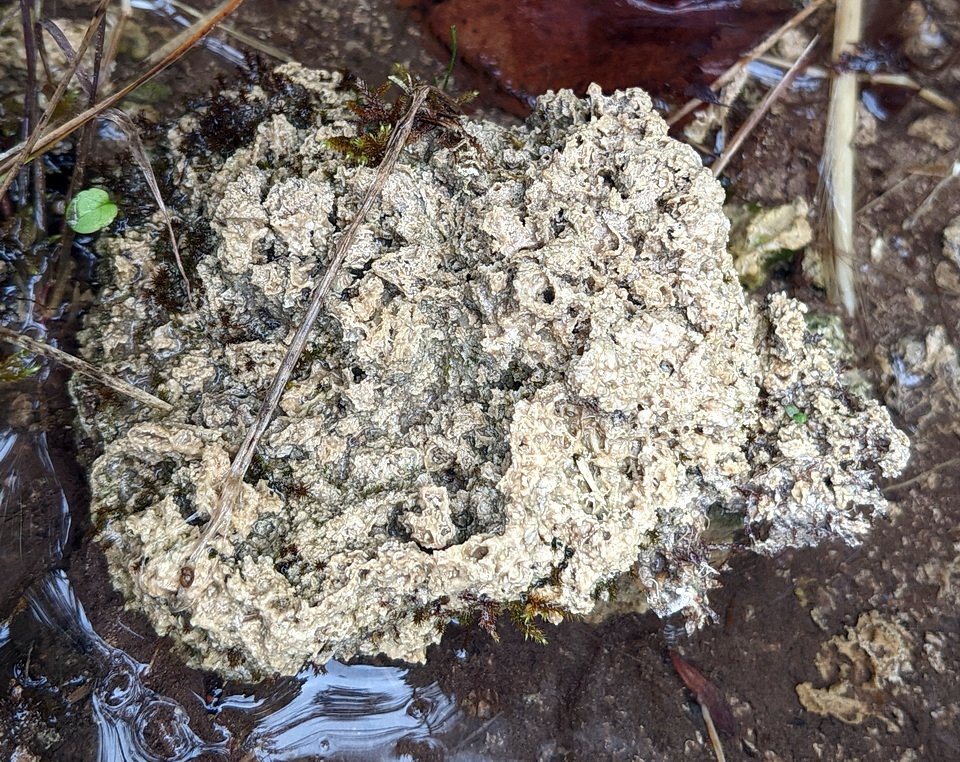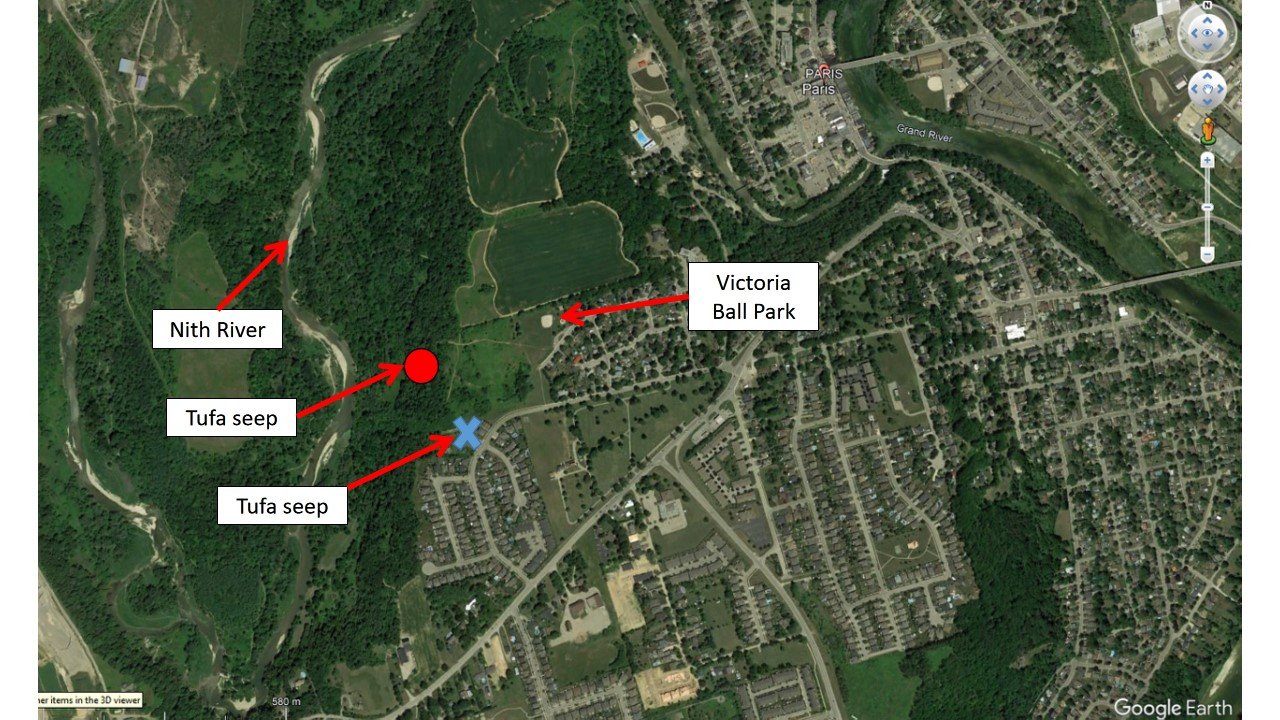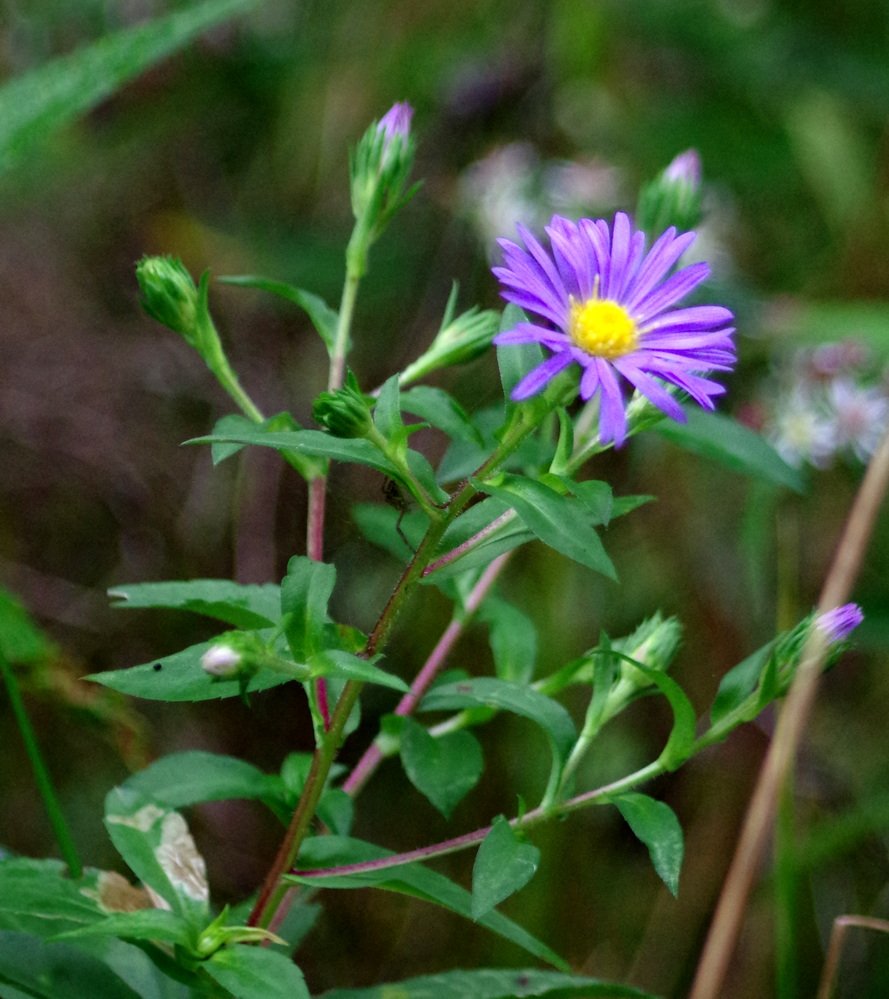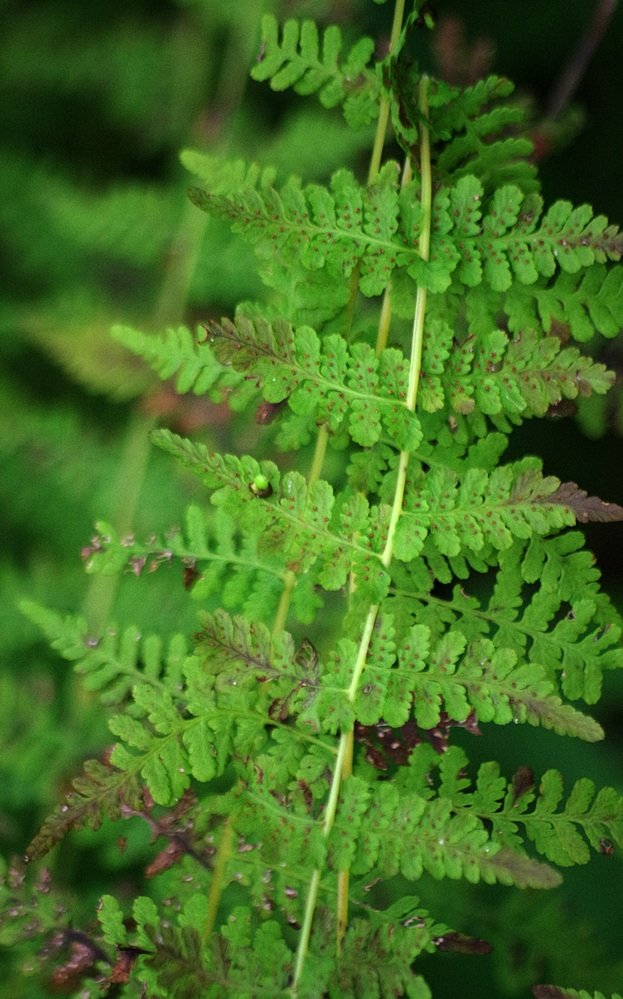Paris (Ontario) Tufa Plants
I am constantly looking for tufa deposits because they are not common and they can support interesting and rare calcicolous plant communities. In summer, 2022, I saw an excellent tufa deposit near Paris, Ontario (Photo 1), thanks to the direction shared with me by Wasyl Bakowsky (see acknowledgement at the end of the note). The tufa and associated groundwater seep is located at the bottom of a ridge at: Lat: 43.187286; Long: -80.396662, on the west edge of Paris, Ontario. In this note, I refer to this deposit as the Paris tufa.
Photo 1: Location of the Paris tufa, close to the Nith River, Paris, Ontario, Canada. Location map created using Google Earth satellite base. The blue “X” shows a parking area. At the time of visit (Sept 21/22), there was a lot of construction between Victoria Park and the Nith River, rendering that area impassable.
What Is Tufa?
Tufa is a type of calcium carbonate rock formed by the precipitation of the mineral calcite from calcareous groundwater. The tufa rock has a composition similar to limestone. Texturally, tufa is very porous, light weight, and is generally light brown or tan in colour (Photo 2). Chemically, tufa contains a lot of the element calcium, in the form of the mineral calcite, and very little of the elements nitrogen, potassium and phosphorous, which are important plant nutrients. For more features of tufa, check out this note entitled “Flowstone, travertine, and tufa”.
Photo 2: A piece of loose tufa from the Paris tufa deposit. Note the very porous nature of the tufa material. Photo by: Andy Fyon, Sept. 21/22.
How Does Tufa Form?
Tufa can form on the land surface by precipitation of calcite from groundwater rich in the element calcium and carbon dioxide (CO2) gas. Groundwater becomes rich in calcium and CO2 gas when it reacts with limestone rock or glacial deposits containing lots of finely ground calcareous rock flour. Generally the temperature of this groundwater is the same as the ambient, low temperature of the geological material through which the groundwater flows. When that low temperature groundwater exits onto the land surface, dissolved CO2 gas escapes from the water causing the mineral calcite to precipitate in the form of tufa. You can read more about degassing of groundwater and precipitation of calcite in the note entitled Geochemistry: Simple Conditions Of Calcite Precipitation.
Tufa Habitat And Plants
The chemistry of tufa makes that type of calcareous geological habitat a challenging place for many plants to grow. Having said that, there are plants that are specially adapted to grow on wet, calcareous, tufa substrates. These are called calcicolous plants and those tolerate or thrive in natural calcareous habitats. Tufa containers are commonly used by gardeners to hold special plants.
Geology Of The Paris Tufa Area:
The geology of the Paris tufa area is subdivided into two types of geological material:
bedrock geology; and
surficial geology.
These two different types of geological material are described separately below. I have summarized the geological descriptions and highlighted the phrase calcareous rock where limestone and dolostone are abundant or where surficial deposits occur that are likely to contain calcareous material. The presence of calcareous material in the subsurface is likely important and bears on some geochemical aspects of the groundwater spring responsible for the Paris tufa.
Bedrock geology
Bedrock geology (Photo 3) is a general term that refers to the solid rock that lies beneath the soil and other surficial materials like glacial and fluvial sand and gravel deposits. In this part of Ontario, the bedrock consists of Paleozoic sedimentary rocks that formed between 541 million years ago and 252 million years ago. These rocks were deposited in a large sedimentary basin at a time when life forms developed from simple algae through primitive marine invertebrates.
Photo 3: Simplified bedrock of the Paris tufa area. The tufa is located at the pin with the associated Latitude and Longitude. Each colour represents a different geological unit. The numbers associated with each map coloured unit are keyed to the rock description below. Geology from OGS Earth superimposed on a Google Earth image.
On the bedrock geology map of the Paris tufa area (Photo 3), each coloured area corresponds to a different geological rock unit. The youngest deposit occurs at the top of the following list. The groundwater seep responsible for the formation of the tufa deposit occurs at the base of a glacial till unit which overlies the calcareous and evaporitic rocks of the Salina Formation (Unit 4, Photo 3).
Summary of Bedrock Geology In The Paris Tufa Region
9: Dundee Group, Dundee Formation: calcareous rock; limestone, which is locally cherty, and minor dolostone.
8: Lucas Group / Detroit River Group, Lucas Formation: calcareous rock; sandy limestone, limestone, and dolostone.
7: Amherstburg Group / Detroit River Group, Amherstburg Formation: calcareous rock; bituminous, cherty, locally biohermal limestone and dolostone (also known informally as dolomite) (about 393 to 382 million years old).
6: Bois Blanc Group, Bois Blanc Formation: calcareous rock; cherty and argillaceous limestone and dolostone (also known informally as dolomite), associated locally with glauconitic sandstone (about 422 to 394 million years old).
5: Bass Islands Group, Bass Islands Formation: calcareous rock; laminated or mottled or argillaceous dolostone (also known informally as dolomite) (444 to 419 million years old).
4: Salina Group, Salina Formation: calcareous rock and evaporites; dolostone (also known informally as dolomite), shale, gypsum and salt evaporites. The presence of salt and gypsum minerals tell us that the Salina Formation formed in a shallow, warm sea that was subject to evaporation. (about 400 million years old). The Paris tufa was deposited on top of surficial sedimentary deposits that lie on basement rocks of the Salina formation.
3: Guelph Group, Guelph formation: calcareous rock; consists of dolostone (also known informally as dolomite), which is fossiliferous, locally biohermal and locally bituminous (450 million years old);
2: Amabel Group, Amabel formation: calcareous rock; consists of dolostone (also known as dolomite), which is thick-bedded, crinoidal, locally biohermal, and locally bituminous. This is a hard rock that serves as a cap to the Niagara Escarpment (425 million years old).
1: Queenston Group, Queenston formation: consists of Description: shale, siltstone, minor limestone and sandstone (461 million to 444 million years old).
Bedrock summary: calcareous bedrock
Key to this discussion is the abundance of limestone and dolostone rock. These calcareous rocks react with groundwater to create water that is rich in carbon dioxide gas and the element calcium, both of which play an important role in the formation of tufa.
Surficial geology
Surficial geology, also known as Quaternary geology, refers to those unconsolidated geologic materials that lie on top of the bedrock. Although the Quaternary era includes the last 1.81 million years of Earth history, in Ontario almost all surficial sediments are much younger (<45,000 years old). The sediments were deposited either during or after the last ice age. Common surficial materials include:
sand and gravel;
glacial tills;
clay and silt.
On the surficial geology map of the Paris tufa area (Photo 4), each coloured area corresponds to a different surficial geological deposit. The youngest deposit occurs at the top of the following list.
Photo 4: Surficial geology map of the Paris tufa area. The different geological deposits are coloured in different colours: Brown: modern alluvial deposits; Red lines: fluvial terraces; Sand-yellow Glaciolfluvial deposits; dark green: unsubdivided glacial till; lime green: Stone-poor, sandy silt to silty sand till; and mauve: old Paleozoic bedrock. This bedrock would not normally be included on the surficial geology map, but I have done so because the rock is not covered by any surficial material. Surficial geology map from OGS Earth.
Summary of Surficial Geology In The Paris Tufa Region
6: Brown-coloured map unit: modern alluvial deposits that were deposited by rivers. The alluvium material consists of clay, silt, sand, and gravel as well as organic matter. Alluvial deposits occur more commonly as overbank deposits, floodplain deposits and deltas.
5: Red-coloured map lines: Fluvial terraces which are elongated terraces, or strips of land, located on the sides of a floodplain or river valley. The level strip of land, called a "tread", is separated from an adjacent floodplain, other fluvial terraces, or uplands by steeper panels of land called "risers". These terraces lie parallel to, but above, the river channel and its floodplain.
4: Sand-yellow coloured map unit: Glaciofluvial deposits consisting of river and delta deposits. Glaciofluvial landforms are created by the action of glacier meltwater. They can be erosional or depositional landforms, and can form underneath, on top of, in front of, and around the edges of former glaciers.
3: Dark green-coloured map unit: Unsubdivided glacial till consisting of older tills; this unit may also include stratified deposits.
2: Lime green-coloured map unit: Stone-poor, sandy silt to silty sand-textured glacial till, which lies on top of the ancient bedrock.
1: Mauve-coloured map unit: ancient bedrock, known by geologists as Paleozoic bedrock, which is exposed in the river valley. This bedrock would not normally be included on the surficial geology map, but I have done so because the rock is not covered by any surficial material.
Surficial geology summary: tills
Key to this discussion is the presence of till deposits at the base of the sediments (Unit 3, coloured dark green on the surficial geology map, Photo 4). I assume the tills consist of calcareous material because they would have formed by glacial erosion of the local calcareous, Paleozoic bedrock. Calcareous materials in the till react with groundwater to create water that is rich in carbon dioxide gas and the element calcium, both of which play an important role in the formation of tufa.
Description of the Paris Tufa
The Paris tufa occurs as discrete loose, porous blocks that appear to show casts of degraded vegetation (Photo 2 and 5). These loose blocks occur downslope from the groundwater discharge site. The surface water that drains the tufa flows downslope towards the Nith River.
Photo 5: Blocky deposits of tufa located several meters fron the groundwater discharge site, in an area of active and continuous water flow. Image by: Andy Fyon, Sept. 21, 2022.
In places, where the land gradient appears to be steeper, and farther away from the groundwater discharge site, stepped tufa terraces are developed (Photo 6). The height of each step is about 20 cm or less. The stepped tufa is located close to the transition to low-slope wetland.
Photo 6: Tufa steps located at the base of the area where the discharged groundwater flows towards a wetland. Image by: Andy Fyon, Sept. 21, 2022.
Precipitates of crusty white material, presumed to be calcite, locally coat vegetation, such as moss, in areas where the surface water flow is continuous (Photo 7).
Photo 7: The white, crusty material appears to be calcite that has precipitated on moss and other vegetation. Image by: Andy Fyon, Sept. 21, 2022.
Groundwater:
The groundwater seep responsible for the formation of the tufa deposit discharges from the base of a glacial till unit (Unit 3 on the surficial geology map) (Photo 8). I saw no bedrock in this immediate area, so I assume the groundwater flowed through the subsurface tills before discharging onto the land surface; however, I assume the subsurface bedrock is located close to, but underneath, the valley floor of the Nith River. That means the groundwater could have been in contact and reacted with the calcareous bedrock.
Photo 8: The approximate discharge site of the groundwater seep occurs at the base of a till deposit, Image by: Andy Fyon, Sept 21, 2022.
I tested the pH of the surface water at several locations across the tufa using pH paper. In my experience, this method is suitable to identify if the water is acidic or alkaline. The pH of the surface water was about 7.0 (Photo 9).
Photo 9: The approximate pH of the surface water covering the Paris tufa is about .7.0. Image by Andy Fyon, Sept. 21.22.
Paris Tufa Plants:
I visited the Paris tufa on September 21, 2022, late in the growing season. Therefore, I report only those plants that I recognized and those which were still in flower. I only report plant species that I saw growing on tufa and and in the active drainage area.
White turtlehead (Chelone glabra)
White Turtlehead (Chelone glabra) is also known informally as smooth balmony, snakehead, and turtlehead (Photo 10 and 11). The shape of this native flower is reported to account for the genus name, “Chelone”, which is derived from the Greek word “chelone”, meaning "a tortoise".
Photo 10: White Turtlehead (Chelone glabra) growing in a wet area of active drainage on calcareous tufa substrate. Photo composed by Andy Fyon, at the Paris tufa, Paris Ontario, Sept. 2122.
Photo 11: More detail of White Turtlehead (Chelone glabra) growing in a wet area of active drainage on calcareous tufa substrate. Photo composed by Andy Fyon, at the Paris tufa, Paris Ontario, Sept. 2122.
Its habitat includes marshes, moist stream banks, wet ditches, moist low meadows, and moist woodlands.
Curious to me is that some resources cite preferred substrate is slightly acidic (pH < 6.8), while other references suggest that Chelone glabra is an indicator plant of fens, where the ground water ranges from slightly acid to alkaline. Typically, tufa substrate like that at the Paris tufa is composed of calcium carbonate, which is not indicative of acidic conditions.
Spotted jewelweed (Impatiens capensis)
I was not surprised to find spotted jewelweed (Impatiens capensis) growing in the wet soil of the Paris tufa (Photo 12). Spotted jewelweed is also informally known as orange jewelweed, orange-touch-me-not, and spotted touch-me-not. It was not common on the tufa, but I caution, I visited the seep late in the growing season and I likely missed many plants.
Photo 12: Spotted jewelweed (Impatiens capensis) growing growing in a wet area of active drainage on calcareous tufa substrate. Photo composed by Andy Fyon, at the Paris tufa, Paris Ontario, Sept. 2122.
What does surprise me is that Impatiens capensis is reported to have a low “CaCO3 tolerance”, suggesting to that it does not do well in the calcareous habitat represented at the Paris tufa seep. Perhaps its apparent low abundance is a testament to its low CaCO3 tolerance.
The Genus name comes from the Latin word impatiens meaning impatient attributed to the dramatic, and violent, seed discharge from the ripe pods. By the way, that is a great exercise to enjoy with young children. If you happen to come across this plant on a rainy day, not doubt you will notice that the rain drops bead up on the leaves to create sparkling droplets. This is said to give rise to the common name of jewelweed.
Swamp aster (Symphyotrichum puniceum)
I found swamp aster (Symphyotrichum puniceum), formerly Aster puniceum, growing in the middle of the wet tufa (Photo 13 and 14). This native wildflower is also known informally as bog aster, bristly aster, and red-stemmed aster. It has also has been called early purple aster, cocash, swanweed, and meadow scabish.
Photo 13: Swamp aster (Symphyotrichum puniceum) growing growing in a wet area of active drainage on calcareous tufa substrate. Photo composed by Andy Fyon, at the Paris tufa, Paris Ontario, Sept. 2122.
Photo 14: Profile of swamp aster (Symphyotrichum puniceum) growing growing in a wet area of active drainage on calcareous tufa substrate. Photo composed by Andy Fyon, at the Paris tufa, Paris Ontario, Sept. 2122.
I also read that there are two varieties of Symphyotrichum puniceum. The variety var. puniceum is present throughout the eastern half of the US and all across Canada.
Its preferred habitat includes moist to wet meadows and fields, shores of rivers or lakes, swamps, wetland margins, and ditches.
I looked briefly for a discussion of the influence of substrate chemistry on the distribution of this species, but I could not find any discussion of the influence of substrate pH on the location of this species.
Broad-leaved goldenrod / zigzag goldenrod (Solidago flexicaulis)
This species was growing around the margins of the tufa, but not on the wet seep itself (Photo 15). Technically, I would say it is not a seep obligate, but it was common on the slopes of the ravine near the seep.
Photo 15: Zigzag goldenrod (Solidago flexicaulis) growing growing in a wet area of active drainage on calcareous tufa substrate. Photo composed by Andy Fyon, at the Paris tufa, Paris Ontario, Sept. 2122.
According to VASCAN, the accepted common name of Solidago flexicaulis is zigzag goldenrod.
It is a native woodland goldenrod, with erect, somewhat zig-zag stems. Its preferred habitats include stream banks, rich woods and slopes underlain by weakly acidic soils (pH <6.8), although it tolerates lime-bearing (e.g., alkaline?) substrates.
Great blue lobelia (Lobelia siphilitica)
Lobelia siphilitica is another vascular plant that I saw growing in the moist calcareous tufa. It is also informally known as great lobelia and blue cardinal flower (Photo 16 and 17).
Photo 16: Great blue lobelia (Lobelia siphilitica) growing growing in a wet area of active drainage on calcareous tufa substrate. Photo composed by Andy Fyon, at the Paris tufa, Paris Ontario, Sept. 2122.
Photo 17: Great blue lobelia (Lobelia siphilitica) growing growing in a wet area of active drainage on calcareous tufa substrate. Photo composed by Andy Fyon, at the Paris tufa, Paris Ontario, Sept. 2122.
Although this native, poisonous plant can approach a meter in height, the few plants I saw were about 0.5 metre tall (1.5 feet).
It grows in a range of wet conditions, including open, wet woods, stream banks, marshes, and moist meadows. Preferred soil pH is alkaline to neutral, so it tolerates the calcareous conditions of the Paris tufa seep.
Bulblet fern (Cystopteris bulbifera)
I was happy to see bulblet fern (Cystopteris bulbifera) growing in moist soil in the Paris tufa (Photo 18). It is also informally known as bulblet bladderfern, or bulblet fragile fern.
Photo 18: Bulblet fern (Cystopteris bulbifera) growing growing in a wet area of active drainage on calcareous tufa substrate. Photo composed by Andy Fyon, at the Paris tufa, Paris Ontario, Sept. 2122.
Cystopteris bulbifera is unusual among ferns because it produces bulblets along the bottom of the fronds (Photo 19). I find this one of the easiest field criteria to identify Cystopteris bulbifera.
Photo 19: One bulblet visible of this frond of bulblet fern (Cystopteris bulbifera) growing growing in a wet area of active drainage on calcareous tufa substrate. Photo composed by Andy Fyon, at the Paris tufa, Paris Ontario, Sept. 2122.
It is a fern species that I now expect to see growing on moist calcareous substrates. In fact, it is reported to grow only on calcareous substrates, like limestone, dolostone, and calcareous seeps.
Thallose liverwort (Conocephalum salebrosum)
At the Paris tufa, Conocephalum salebrosum grows on moss covered tufa and rock substrate in the wet areas (Photo 20 and 21). It is informally known as snakeskin liverwort, cat-tongue liverwort, mushroom-headed liverwort, and great scented liverwort.
This is a non-vascular land plant. It is Holarctic in distribution, meaning that it occurs in habitats found throughout the northern continents.
Conocephalum salebrosum is commonly found in moist, shaded and calcareous habitats, including limestone. The wet Paris tufa, which is chemically similar to limestone, appears to be a appropriate habitat for this thallose liverwort.
Photo 20: Thallose liverwort (Conocephalum salebrosum) growing in a wet area of active drainage on calcareous tufa substrate. Photo composed by Andy Fyon, at the Paris tufa, Paris Ontario, Sept. 2122.
Photo 21: Thallose liverwort (Conocephalum salebrosum) growing on a wet, mossy substrate immediately beside the calcareous Paris tufa. Photo composed by Andy Fyon, at the Paris tufa, Paris Ontario, Sept. 2122.
Summary:
The Paris tufa deposit occupies an area of approximately 90 square metres (1000 square feet). A groundwater discharge issuing from glacial till at the base of a ravine ridge appears to be the water source from which the tufa formed. The pH of that groundwater is about 7.0. The discharge water flows down a gentle slope into a wetland associated with the Nith River.
During a fall visit to the Paris tufa, I saw several calcicolous and calcareous-tolerant vascular and nonvascular plant species growing on the wet calcareous substrate, including Cystopteris bulbifera.
Acknowledgement
I extend a big thanks to Wasyl Bakowsky, Community Ecologist, Natural Heritage Information Centre (Northern Development, Mines, Natural Resources and Forestry (NRF)). Wasyl alerted me to the presence of the Paris (Ontario) tufa system and graciously provided several key plant identifications to “new-to-me” species.





















